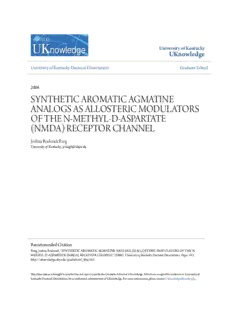
synthetic aromatic agmatine analogs as allosteric modulators of the n-methyl-d-aspartate PDF
Preview synthetic aromatic agmatine analogs as allosteric modulators of the n-methyl-d-aspartate
UUnniivveerrssiittyy ooff KKeennttuucckkyy UUKKnnoowwlleeddggee University of Kentucky Doctoral Dissertations Graduate School 2006 SSYYNNTTHHEETTIICC AARROOMMAATTIICC AAGGMMAATTIINNEE AANNAALLOOGGSS AASS AALLLLOOSSTTEERRIICC MMOODDUULLAATTOORRSS OOFF TTHHEE NN--MMEETTHHYYLL--DD--AASSPPAARRTTAATTEE ((NNMMDDAA)) RREECCEEPPTTOORR CCHHAANNNNEELL Joshua Roderick Ring University of Kentucky, [email protected] RRiigghhtt cclliicckk ttoo ooppeenn aa ffeeeeddbbaacckk ffoorrmm iinn aa nneeww ttaabb ttoo lleett uuss kknnooww hhooww tthhiiss ddooccuummeenntt bbeenneefifittss yyoouu.. RReeccoommmmeennddeedd CCiittaattiioonn Ring, Joshua Roderick, "SYNTHETIC AROMATIC AGMATINE ANALOGS AS ALLOSTERIC MODULATORS OF THE N-METHYL-D-ASPARTATE (NMDA) RECEPTOR CHANNEL" (2006). University of Kentucky Doctoral Dissertations. 413. https://uknowledge.uky.edu/gradschool_diss/413 This Dissertation is brought to you for free and open access by the Graduate School at UKnowledge. It has been accepted for inclusion in University of Kentucky Doctoral Dissertations by an authorized administrator of UKnowledge. For more information, please contact [email protected]. ABSTRACT OF DISSERTATION Joshua Roderick Ring The Graduate School University of Kentucky 2006 SYNTHETIC AROMATIC AGMATINE ANALOGS AS ALLOSTERIC MODULATORS OF THE N-METHYL-D-ASPARTATE (NMDA) RECEPTOR CHANNEL ______________________________________________________ ABSTRACT OF DISSERTATION ______________________________________________________ A dissertation submitted in partial fulfillment of the requirements for the degree of Doctor of Philosophy in the College of Pharmacy at the University of Kentucky By Joshua Roderick Ring Lexington, Kentucky Director: Dr. Peter A. Crooks, Professor of Pharmaceutical Sciences Lexington, Kentucky 2006 Copyright © Joshua Roderick Ring 2006 ABSTRACT OF DISSERTATION SYNTHETIC AROMATIC AGMATINE ANALOGS AS ALLOSTERIC MODULATORS OF THE N-METHYL-D-ASPARTATE (NMDA) RECEPTOR CHANNEL The N-methyl-D-aspartate (NMDA) receptors are highly regulated ligand-gated ion channels, which are affected by many substrates. Overactivation of the NMDA receptor can lead to hyperexcitability and a number of neurotoxic effects and neurological diseases. Agmatine has been demonstrated to act allosterically as an inhibitory modulator at the polyamine recognition sites of the NMDA receptor complex. The present study synthesized and evaluated a library of agmatine analogs for their ability to displace tritiated MK-801 from NMDARs in P2 membrane preparations from rat brains at ligand concentrations of 1 mM and 50 uM. A full dose-response curve was generated for the most active compounds, in the presence and absence of a pathological level of spermidine (100 uM). A forty-five member subset of arylidenamino-guanidino compounds was synthesized and all were demonstrated to be NMDA receptor inhibitory modulators in the above assay. Three of these compounds generated biphasic curves, indicating activity at two binding sites: the postulated high-affinity agmatine binding site, and a low-affinity site (perhaps the channel itself). (4-Chlorobenzylidenamino)-guanidine hydrochloride demonstrated an IC50 of 3.6 uM at the former site and 124.5 uM at the latter. Several computer models were generated to direct further synthesis. Based on the structure- activity relationship of the arylidenamino-guanidino compounds, a pharmacophore model of the agmatine binding site of the NMDAR was proposed. KEYWORDS: Agmatine, N-Methyl-D-Aspartate Receptors, NMDAR Inhibition, Polyamine Binding Sites, Arylidenamino-Guanidine Joshua Roderick Ring _____________________ March 30, 2006 _____________________ SYNTHETIC AROMATIC AGMATINE ANALOGS AS ALLOSTERIC MODULATORS OF THE N-METHYL-D-ASPARTATE (NMDA) RECEPTOR CHANNEL By Joshua Roderick Ring Peter A. Crooks _____________________________ Director of Dissertation Jim R. Pauly _____________________________ Director of Graduate Studies March 30, 2006 _____________________________ RULES FOR THE USE OF DISSERTATION Unpublished dissertations submitted for the Doctor’s degree and deposited in the University of Kentucky Library are as a rule open for inspection, but are to be used only with due regard to the rights of the authors. Bibliographical references may be noted, but quotations or summaries of the parts may be published only with the permission of the author, and with the usual scholarly acknowledgments. Extensive copying or publication of the dissertation in whole or in part also requires the consent of the Dean of the Graduate School of the University of Kentucky. A library that borrows this dissertation for use by its patrons is expected to secure the signature of each user. Name Date DISSERTATION Joshua Roderick Ring The Graduate School University of Kentucky 2006 SYNTHETIC AROMATIC AGMATINE ANALOGS AS ALLOSTERIC MODULATORS OF THE N-METHYL-D-ASPARTATE (NMDA) RECEPTOR CHANNEL ______________________________________________________ DISSERTATION ______________________________________________________ A dissertation submitted in partial fulfillment of the requirements for the degree of Doctor of Philosophy in the College of Pharmacy at the University of Kentucky By Joshua Roderick Ring Lexington, Kentucky Director: Dr. Peter A. Crooks, Professor of Pharmaceutical Sciences Lexington, Kentucky 2006 Copyright © Joshua Roderick Ring 2006 Acknowledgments I would like to use this opportunity to express my appreciation for a myriad of kind and generous souls who have joined me in this journey. Firstly, Dr. Peter Crooks, who has guided me throughout the course of this work with patience and passion, and Dr. John Littleton, who led me through the perils of pharmacology. Secondly, those who have been members of my dissertation committee who have taken the time to challenge me: Dr. Marcos Oliveira, Dr. Jim Geddes, Dr. Jurgen Rohr, and Dr. George Digenis. I would also like to thank Dr. Bettye Hollins for serving as my outside examiner for the defense of this dissertation. The continuous help and support of many people has allowed me to learn and grow as a scientist in the laboratory. The entire group of Dr. Crooks has been instrumental in my chemical knowledge and discovery, especially Dr. Sundar Neelakantan and my cohort Aaron Haubner. I must also express my gratitude to the group of Dr. Littleton for patiently allowing me to learn some laboratory pharmacology, particularly Robert Holley and Dr. D. Trent Rogers. Dr. Sean Parkin was generous enough to generate the X-Ray crystallographical material contained in this work, and Dr. Fang Zheng spent many hours assisting me in the creation of the PLS and ANN models. To my parents, my sisters, and my friends: thank you all for being there when I needed you. And to Leigh, for listening and always loving. iii
Description: